BestReviews is reader-supported and may earn an affiliate commission. Details
Jennifer specializes in kitchen, cleaning and home design, having written over 100 articles on these topics.
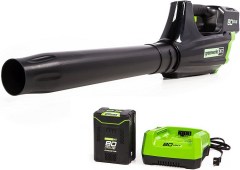
An extra-powerful battery model that delivers up to 170 mph of air power.
An extra-powerful battery model that delivers up to 170 mph of air power.
At 60 decibels, it runs quieter than some other leaf blowers. Includes an 80-volt battery and charger. Battery life is up to 70 minutes per charge on the lowest setting.
Some questions about longevity of the blower.
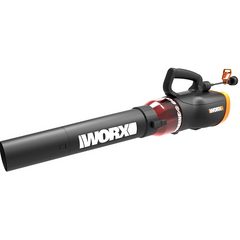
This corded option with a 12-amp motor packs a real punch.
This corded option with a 12-amp motor packs a real punch.
Power is good for landscaping use. Multiple speed controls. Airflow of up to 110MPH and air movement up to 600CFM. Attachment nozzle to focus on tighter area.
6.4 pounds is on heavier side.
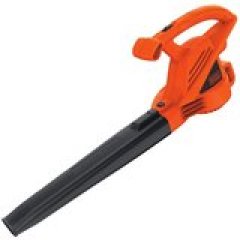
A powerful corded model that's easy to carry thanks to its lightweight design.
A powerful corded model that's easy to carry thanks to its lightweight design.
Extended handle for comfort. Weighs 4.4 pounds for continuous use. Impressive air speed of 180MPH. Works for cleaning on firm surfaces.
Motor is only 7 amps. 180 CFM air movement is on lower side.
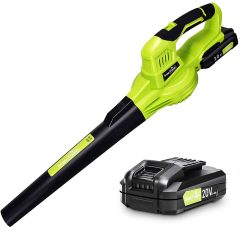
This 2-speed rechargeable option is great for use both inside and outside.
This 2-speed rechargeable option is great for use both inside and outside.
Portable. Ergonomic handle. 2 speeds. Adjustable tube to accommodate user height and tough places. Rechargeable 20V lithium ion battery.
Some users say it does not last long on a single charge.

A powerful cordless blower that can move up to 459 cubic feet of air per minute at 116 mph.
A powerful cordless blower that can move up to 459 cubic feet of air per minute at 116 mph.
Model has a convenient control lever with a variable-speed trigger and lock for continuous operation. An in-line fan offers better balance for ease of operation. Quite powerful for the price.
The air intake creates a lot of suction and can snag your clothing if you're not careful.

We recommend these products based on an intensive research process that's designed to cut through the noise and find the top products in this space. Guided by experts, we spend hours looking into the factors that matter, to bring you these selections.
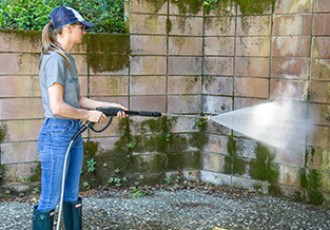
A leaf blower makes the chore of removing leaves from your yard much easier. If you want a leaf blower that requires little maintenance, an electric leaf blower fits the bill.
Instead of using gas to power the engine, an electric leaf blower features either a cord or a rechargeable battery. You don’t have to worry about adding gas and oil to keep it running. An electric leaf blower is lighter and easier to carry and start than most gas leaf blowers, and it doesn’t create fumes or vibrate much during operation.

Corded electric leaf blowers have a power cord and must be plugged into an outlet. They’re easy to maintain and extremely lightweight because they don’t have a gas engine or even a battery pack to weigh them down. However, the cord limits how far you can move with the leaf blower. As such, corded models tend to be best for small yards.
Cordless electric leaf blowers feature a battery pack, so no cord needs to be plugged in. Without a cord in tow, it’s much easier to navigate the yard. Notably, the lack of a cord does make corded blowers a little less powerful, and you may need to stop to recharge the battery if you’re working on a large area. Corded models are usually heavier, too, due to the weight of the battery pack.
Handheld electric leaf blowers are the most common option, featuring a handle, main component with motor, and nozzle. They’re specifically liked for their light weight.
Backpack leaf blowers are heavier but also more powerful, consisting of a shoulder harness that holds the motor on your back and a nozzle attached to a hose. If you must blow leaves for long periods, a backpack blower is often the better option.
An electric leaf blower’s motor power is determined mainly by its voltage, measured in amps. Most have 7 to 12 amps. The higher the amp rating, the more powerful the machine. Most electric leaf blowers with an 8-amp or higher motor work well for home use.
In addition to voltage, most leaf blower manufacturers provide two other numbers to tell you how powerful a leaf blower is: cubic feet per minute (CFM) and miles per hour (MPH).
CFM represents the volume of air a leaf blower can move. A leaf blower with a high CFM can move many leaves at once. Most consumers seek a blower with a CFM of 350 or higher.
MPH represents how fast the air from a leaf blower moves. A high-MPH leaf blower can move heavier debris easily, including wet leaves. Most consumers seek a model that operates at 150 MPH or faster.
While a leaf blower’s CFM and MPH both indicate how it will perform, CFM is a more significant measure.
While a leaf blower can help make it easier to clear your yard of leaves, you’ll still likely appreciate having a rake to maneuver the leaf piles.
Since you’ll either be wearing an electric leaf blower on your back or holding it in your hand, its weight is a vital consideration. Most electric blowers weigh between 5 and 14 pounds. Corded leaf blowers tend to weigh less than cordless leaf blowers because the battery pack of a cordless blower provides additional weight.
Most consumers prefer a corded leaf blower that weighs 8 pounds or less. For cordless leaf blowers, a leaf blower that weighs less than 10 pounds is the typical ideal.
Some handheld electric leaf blowers feature more than one hand grip. An extra hand grip makes it easier to control the blower and allows you to better distribute the weight of the tool when holding it.
The design of a leaf blower’s nozzle can affect its performance. Some have a flat, rectangular nozzle; others have a rounded design. A flat nozzle generally works best for loose leaves, but for leaves that are embedded in the lawn, a round nozzle is more effective.
Multiple nozzles are an option on some electric leaf blowers. You can change the nozzle depending on the job at hand.
Basic electric leaf blowers often operate at just one speed, but those with a bit more sophistication offer multiple speeds. You can use a higher speed for hard surfaces and a slower speed in areas where you want to be more careful, such as flower beds and other areas with delicate landscaping.
Electric leaf blowers with variable speed may offer anywhere from two and six speed choices.
The vibration of an electric leaf blower can make it difficult for some people to comfortably hold. Leaf blowers with vibration reduction make navigation more comfortable.
Compared to gas leaf blowers, electric leaf blowers are less noisy. However, if you’re concerned about noise, look for a model with noise reduction.
A traditional leaf blower operates at between 90 to 115 decibels, but you can find electric leaf blowers that run at 75 decibels or less.

Electric leaf blowers vary in price based on the type, voltage, CFM, MPH, and other features. You could spend anywhere from $20 to $200 on one.
Inexpensive: Budget leaf blowers that cost $20 to $30 are typically low-power corded models. Expect a motor with 7 amps or less of power, an MPH rating of 150 or less, and a CFH of 250 or less.
Mid-range: For $30 to $65, you can find high-powered corded models and cordless models with mid-range power. Expect to see motors with 7 amps or higher, 150 MPH or higher, and 250 CFM or higher.
Expensive: The priciest electric leaf blowers cost from $65 to $200. Whether corded or cordless, these are high-power models with 12-amp to 14-amp motors, MPH ratings of 200 or higher, and CFS ratings of 300 or higher.
In addition to goggles and earplugs, wear long clothing that covers your arms and legs when using a leaf blower to protect your skin from flying debris.

A. For a medium to large lawn, a cordless backpack electric leaf blower may be the best solution. The cordless nature of the tool provides plenty of mobility, allowing you to easily reach all of the yard’s corners, and a backpack is usually more comfortable to hold when you’re clearing a large area.
A. Most cordless leaf blowers can run 30 to 40 minutes when fully charged. Some high-end models run for an hour. If you have a large property to clear, you’ll probably want a leaf blower with a longer battery life. Another option is to buy an extra battery and keep it charged as a spare.
A. You can use an extension cord with your leaf blower, but be sure to use a cord that’s the proper gauge. For leaf blowers with 12 amps or less, a standard 16-gauge extension cord works well. For a more powerful blower, you’d need a 14-gauge extension cord. Further, make sure the cord you use is rated for outdoor use.
Get emails you’ll love.
Learn about the products you’re wondering if you should buy and get advice on using your latest purchases.
